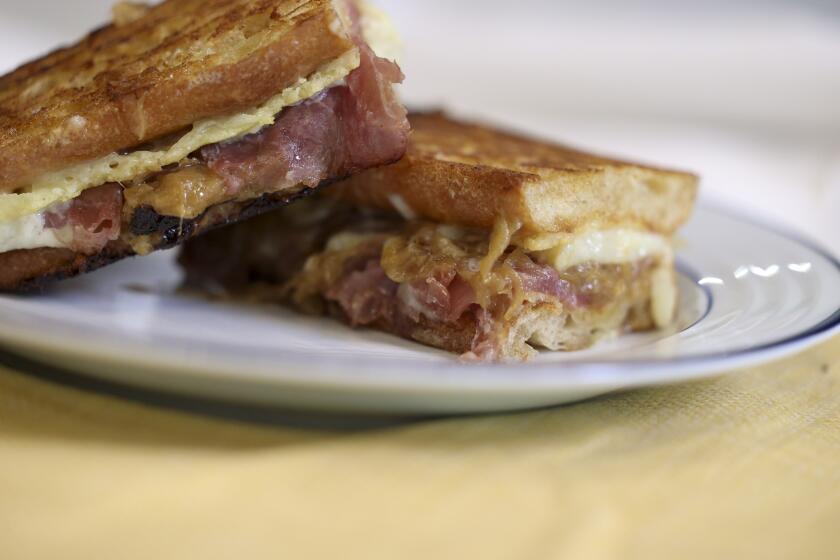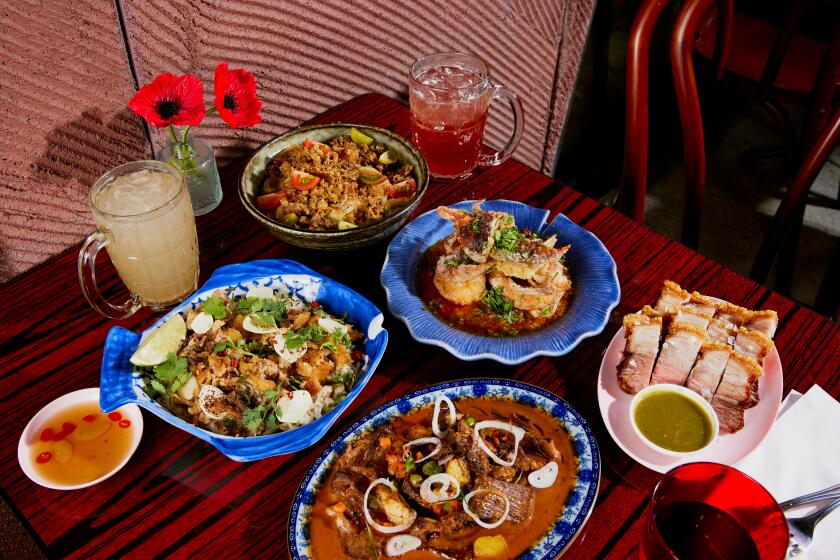Market Watch: Jay Ruskey perks interest with California-grown coffee
When customers stop by Jay Ruskey’s stand at the Santa Barbara farmers market these days, they may or may not be impressed by the likes of the dragon fruit or finger limes he grows, but virtually everyone stops and gawks at the jars of fresh-roasted coffee, flanked by a potted tree.
“I’m totally jazzed; this is great,” says John Wheir of Beacon Coffee Co., a microroaster based in Ventura, who says he had never heard of coffee grown commercially in the continental United States.
Ruskey’s ranch is 15 miles up the coast in Goleta. It’s a lush, hilly paradise of exotic fruits, with the Pacific Ocean and the Channel Islands glimmering in the distance. Ruskey is no less thrilled that his coffee trees, from waist- to shoulder-high, are flourishing and that he has harvested his first real coffee crop after many years of trailblazing preparations.
Mark Gaskell, a University of California farm advisor who has worked in Central America, started the project in 2002 with a vision of developing a local specialty coffee industry similar to the one in Kona, Hawaii. He imported seed and sought to persuade Ruskey, a young and innovative organic farmer, to try growing coffee.
“I wasn’t really thrilled about trying it, but I said I’d give it a whirl,” says Ruskey, who has a degree in agricultural marketing from Cal Poly San Luis Obispo and specializes in growing unusual fruits such as lychees and longans, in addition to avocados and citrus.
Native to Ethiopia, coffee is mostly grown in equatorial and tropical countries such as Colombia and Kenya. The best often comes from high elevations, where moderate temperatures allow the beans — the seeds of small red or yellow berries called coffee cherries — to develop full, balanced flavor. Very hot or freezing temperatures, as well as low humidity, make coffee cultivation difficult or impossible in most of California. But the coastal district near Santa Barbara, shielded by mountains from frosty winter winds and cooled by ocean breezes in summer, offers a potentially suitable environment.
Farmers tried many times over the years to grow coffee in California, but never, at least to this point, succeeded commercially. Dr. L.H. Bascom experimented with it on his farm near Santa Clara in 1858, and five years later the state legislature passed a bounty law encouraging cultivation of exotic crops such as coffee, tea, sugarcane and raw silk. Coffee was raised near Santa Barbara in the 1870s, when the president of the California State Agricultural Society forecast that it would some day be as profitable as citrus. In 1922, William H. Ukers’ authoritative book, “All About Coffee,” declared that “the topographic and climatic conditions in southern California are favorable for its cultivation.”
Obviously, however, the hopes of local coffee pioneers did not pan out, very likely because of high costs for labor and low production compared with more tropical growing districts. But in recent years, interest in specialty coffees — identified by region, variety, processing method and roast style — has surged, giving Gaskell and Ruskey confidence that local coffee cultivation could finally succeed.
“I do not want to do this for a hobby,” emphasizes Ruskey, who lives on the farm with his wife, Kristen, and their three young children. “I want to do it so we have a new crop for the area.”
He started with seedlings in a greenhouse and planted them in spring, 16 months to two years later, on a hillside for good air drainage and frost protection. He now has 470 trees in the ground, which would fill half an acre if they had been planted in a continuous block. By chance, he planted the young trees among mature avocado trees and found that the two were good companions, as the coffee benefited from the rich soil generated by the avocado trees’ mulch.
He has a dozen coffee varieties in the greenhouse ready for trial, but his mature trees are mostly Typica, the Arabica type from which most others developed, and Caturra, a mutation of Bourbon discovered in Brazil. He also has 100 young trees of Geisha, a rare Panamanian strain of Ethiopian origin, legendary for its superb quality.
Sixteen months after planting in the field, the bushes start to bear, in a harvest spread out from July to early October. From flowering to harvest, the cherries stay on the tree for a year or more, which gives Ruskey hope that the long maturation will result in a fine-flavored product. It also raises concerns about the strain on the trees from flowering and fruiting at the same time.
This year his trees produced 130 pounds of finished coffee, which he is selling at the Santa Barbara Tuesday farmers market: 3 ounces — roughly enough to make 10 cups — for $6.
Coffee growers and experts from around the world have visited his planting. “Generally they thought we were crazy, until they saw the crops,” he says. “Then they were pretty impressed.”
He is sufficiently convinced of the feasibility of his project that he and Gaskell are working to organize a Santa Barbara coffee growers association with several other farmers who have planted or committed to planting coffee trees.
It has taken Ruskey several years to acquire the equipment and start developing the expertise to properly process his crop. He uses what is called the wet process: The cherries are harvested by hand and soaked in water for about 24 hours, during which fermentation removes the thin layer of flesh from around the seeds. These are spread out on drying racks for 10 days to three weeks, depending on weather conditions. A thin layer called parchment is ground off the seed, which is then roasted.
As for any pioneer of new crops, Ruskey still has a considerable learning curve ahead of him. A sample of his coffee smelled divine, like most coffee, to this reporter. But Chris Owens, a coffee expert at Intelligentsia’s Pasadena cafe, was not impressed by it in a formal cupping last Tuesday. The beans were of variable maturity, and the flavor was largely masked by crude roasting, he said. “I’d like to see it in its green state and taste it at a light roast to get a fair opinion of the coffee.”
Such problems are solvable, Ruskey says.
“We’re slowly investing in the post-harvest infrastructure,” he says. “Half the game’s post-harvest, but before we were concentrating more on the actual production side of things.”
More to Read
Eat your way across L.A.
Get our weekly Tasting Notes newsletter for reviews, news and more.
You may occasionally receive promotional content from the Los Angeles Times.










